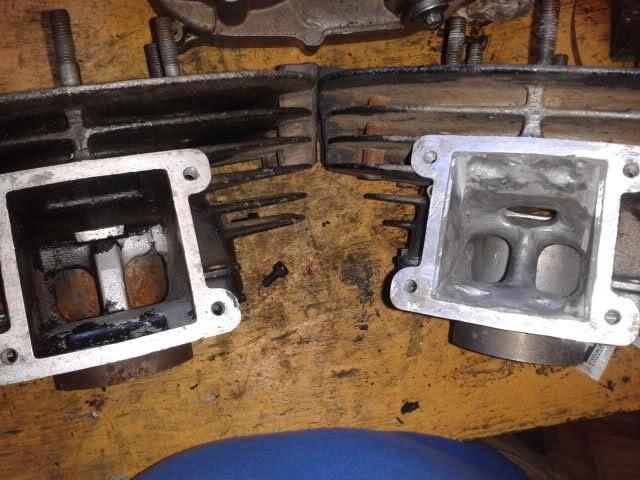Steve Best
Well-Known Member
One piece cheeks?
6203 bearings?
What make is this?
And you are serious that it is a smooth running crank?
My 2015 Grubee 66cc runs very smooth at high rpm, 2012 Grubee 49cc not so much.
And the little black no-name stuffed motor is not bad for vibes but doesn't want to do rpm.
There is a theory that intake cross section should keep a moderately constant cross sectional area to keep flow at a constant speed and hence a maximum rate. Varied cross sectional areas will speed up or slow down flow, ruining flow momentum and cause fuel to drop out of suspension at the slow points. The fuel will not keep up with the air at the fast points too. Any change in diameter should be gradual like a trumpet to conserve momentum of fuel and air, and should be focused on getting around bottlenecks, such as carb venturi or port window, or to amplify resonant waves.
I have worked with this and found good results from following this theory. I worked with the constant area rule on 4 stroke engine ports, and filled 2 stroke reed boxes to achieve the same effect. Notice the plastic filler blocks on the intake side of these reedboxes:

Here is a Yamaha Blaster reedbox filled with epoxy to keep a constant cross-sectional area and to keep intake velocity up.
This was very successful:

The port windows are slightly larger, mainly to match the piston window.
The piston winow was untouched because it is a weak point with this engine.
The port center bridge is untouched for width and far from knife-edged like usually done.
It is actually built up and radiused with thought to how it will flow past the piston.
There are 2 packs of JB Weld and one of epoxy putty filler (about 6oz total) and the aluminum in the sides.
This does act as crankcase "stuffing", everything inside of the reeds does, but primary effect is flow.
This engine had more low end torque, a lower powerband kick in, and reved higher on the pipe.
Wide powerband plus it was dead easy to jet and consistent.
Stock motor is 17hp, this one (with other mods) is about 35 hp and about 2000 more rpm.
My point is bigger is not better, like Butre mentions, flow and other characteristics are important too.
One I noticed with the piston port engine was the value of port mismatch. Didn't expect that...
Steve
6203 bearings?
What make is this?
And you are serious that it is a smooth running crank?
My 2015 Grubee 66cc runs very smooth at high rpm, 2012 Grubee 49cc not so much.
And the little black no-name stuffed motor is not bad for vibes but doesn't want to do rpm.
There is a theory that intake cross section should keep a moderately constant cross sectional area to keep flow at a constant speed and hence a maximum rate. Varied cross sectional areas will speed up or slow down flow, ruining flow momentum and cause fuel to drop out of suspension at the slow points. The fuel will not keep up with the air at the fast points too. Any change in diameter should be gradual like a trumpet to conserve momentum of fuel and air, and should be focused on getting around bottlenecks, such as carb venturi or port window, or to amplify resonant waves.
I have worked with this and found good results from following this theory. I worked with the constant area rule on 4 stroke engine ports, and filled 2 stroke reed boxes to achieve the same effect. Notice the plastic filler blocks on the intake side of these reedboxes:
Here is a Yamaha Blaster reedbox filled with epoxy to keep a constant cross-sectional area and to keep intake velocity up.
This was very successful:
The port windows are slightly larger, mainly to match the piston window.
The piston winow was untouched because it is a weak point with this engine.
The port center bridge is untouched for width and far from knife-edged like usually done.
It is actually built up and radiused with thought to how it will flow past the piston.
There are 2 packs of JB Weld and one of epoxy putty filler (about 6oz total) and the aluminum in the sides.
This does act as crankcase "stuffing", everything inside of the reeds does, but primary effect is flow.
This engine had more low end torque, a lower powerband kick in, and reved higher on the pipe.
Wide powerband plus it was dead easy to jet and consistent.
Stock motor is 17hp, this one (with other mods) is about 35 hp and about 2000 more rpm.
My point is bigger is not better, like Butre mentions, flow and other characteristics are important too.
One I noticed with the piston port engine was the value of port mismatch. Didn't expect that...
Steve



